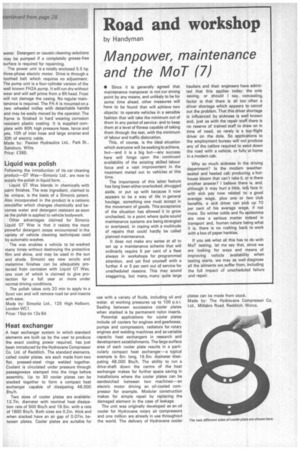Road and workshop
Page 33

If you've noticed an error in this article please click here to report it so we can fix it.
by Handyman
Manpower, maintenance and the MoT (7)
• Since it is generally agreed that maintenance manpower is not our strong point by any means, and unlikely to be for some time ahead, other measures will have to be found that will achieve two objects: to operate vehicles in a sensible fashion that will take the minimum out of them in any period of service: and to keep them at a level of fitness capable of taking them through the test, with the minimum of labour and traffic dislocation.
This, of course, is the ideal situation which everyone will be seeking to achieve, but—and it is a big but—any success here will hinge upon the continued availability of the existing skilled labour force and a vast improvement in the treatment meted out to vehicles at this time.
The importance of this latter feature has long been either overlooked, shrugged aside, or put up with because it now appears to be a way of life in general haulage, something one roust accept in the movement of goods. This acceptance of the situation has allowed it to grow unchecked, to a point where quite sound maintenance systems are being strangled or overtaxed, in coping with a multitude of repairs that could hardly be called planned maintenance.
It does not make any sense at all to set up a maintenance scheme that will ordinarily require 5 per cent of a fleet always in workshops for programmed attention, and yet find yourself with a further 4 or 5 per cent out of service for unscheduled reasons. This may sound staggering, but many, many quite large hauliers and their engineers have admitted that this applies today: the only saving, or should I say, concealing, factor is that there is all too often a driver shortage which appears to cancel out the problem. That this driver shortage is influenced by sickness is well known and, just as with the repair staff there is no reserve of trained staff to draw on in time of need, so rarely is a top-flight driver on the dole. So applications to the employment bureau will not produce any of the calibre required to send down the road with a vehicle, or fully at home in a modern cab.
Why so much sickness in the driving department? Is the modern weathersealed and heated cab producing a hothouse bloom that can't take it, or is there another answer? I believe there is, and. although it may hurt a little, let's face it: with sick pay now related to a good average wage, plus one or two club benefits, a sick driver can pick up 70 per cent of his average wage, if not more. So winter colds and flu epidemics are now a serious matter indeed in transport and, human nature being what it is. there is no rushing back to work with a box of paper hankies.
If you ask what all this has to do with MoT testing, let me say that, since we are looking for ways and means of improving vehicle availability when testing starts, we may as well diagnose all the ailments we suffer from, including the full impact of unscheduled failure and repair.




















































































